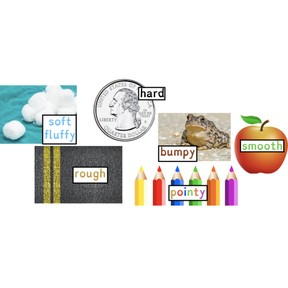
Materials best suited for a task: Texture
I can observe and describe the texture of materials.



8,000 schools use Gynzy
92,000 teachers use Gynzy
1,600,000 students use Gynzy
General
Good scientists can analyze the results of experiences that they create in order to come up with conclusions about the world around them. Students will learn about the properties of matter and materials, and learn about and explore the observable property of texture. They will conduct an investigation where they will observe various snacks to determine what their textures are. This lesson includes activities where students will determine the texture of objects based on their prior knowledge, engage in an experiment where students get to determine the texture of different snacks, and post-experiment activities that include determining the texture of various everyday objects and then determining what material(s) would work best for a specific task. This lesson also includes printable worksheets.
Standards
NGSS: 2-PS1-2
Learning objective
Students will be able to observe and describe the texture of materials in order to help them determine which types of material are best suited for specific tasks.
Introduction
Have students discuss which item, from a given list, would work best in the scenario described. Afterward, explain the best choice would be the beachball. Then, discuss the concept of different textures of materials as a property, and tell students that they will explore this concept in the lesson and experiment today!
Instruction
Teach students about the observable properties of matter. Explain that we can use our five senses to help us determine the observable properties of an object. Provide them an example of how to describe an item (e.g. the banana in the slides) by its observable properties. Then, define and explain the property of texture and provide examples. Afterward, students can engage in the following activities:
First, students will practice sorting different items into texture categories based on their prior knowledge or experiences. Next, they will prepare and then take part in an experiment where they will observe different snacks and candies and describe them by their textures. This experiment includes some data collection by the students during the experiment on a provided chart (on a slide and as a printable worksheet). After the experiment, students can discuss their results and answer some given discussion questions. Then, students can participate in an activity where they click on a spinner and then describe the texture of the object they land on. Finally, students will use their new understanding of textures of different materials to apply to an activity where they will make up a toy that will satisfy given criteria in a make-believe scenario.
Quiz
Students respond to ten multiple-choice questions about properties, the property of texture, and how specific materials are best suited for specific tasks.
Closing
Students will be given a scenario where they have to design and explain an item that would best be suited for a task. Students will need to illustrate the item and then explain their thinking. This closing activity includes a printable worksheet.
Instruction materials
For this lesson’s experiment, the following materials will be needed: pencils, hand sanitizer, small cups or napkins, and 5 various snacks of different textures of your choice. This lesson also includes two printable worksheets.
The online teaching platform for interactive whiteboards and displays in schools
Save time building lessons
Manage the classroom more efficiently
Increase student engagement
Discover more!
About Gynzy
Gynzy is an online teaching platform for interactive whiteboards and displays in schools.
With a focus on elementary education, Gynzy’s Whiteboard, digital tools, and activities make it easy for teachers to save time building lessons, increase student engagement, and make classroom management more efficient.



